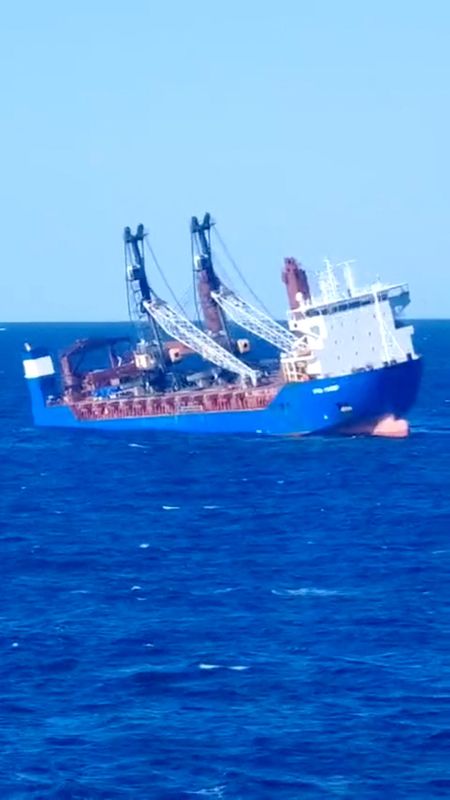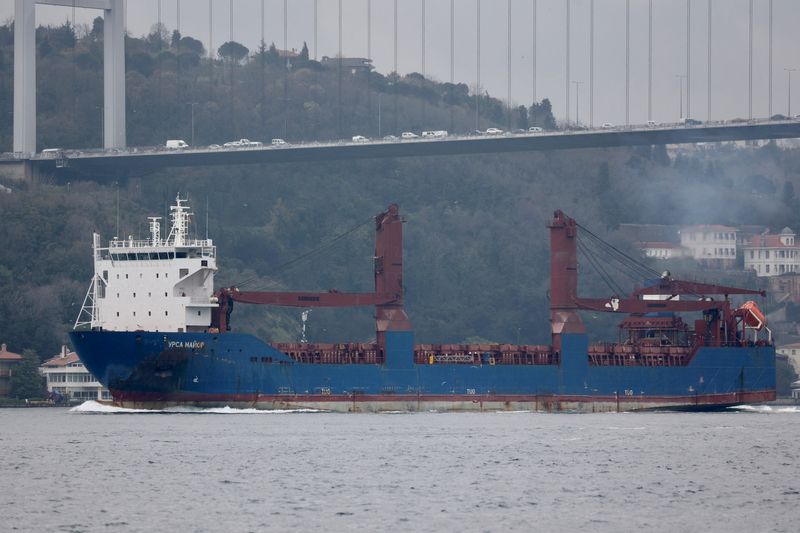By Andrew Osborn and Gleb Stolyarov
MOSCOW (Reuters) - A Russian cargo ship called Ursa Major sank in the Mediterranean Sea overnight after an explosion ripped through its engine room and two of its crew are still missing, the Russian Foreign Ministry said on Tuesday.
The vessel, built in 2009, was controlled by Oboronlogistika, a company that is part of the Russian Defence Ministry's military construction operations, which had previously said it was en route to the Russian far eastern port of Vladivostok with two giant port cranes lashed to its deck.
The Foreign Ministry's crisis centre said in a statement that 14 of the ship's 16 crew members had been rescued and brought to Spain, but that two were still missing. It did not say what had caused the engine room explosion.
Russia's embassy in Spain was cited by the state RIA news agency as saying it was looking into the circumstances of the sinking and was in touch with the authorities in Spain.
Oboronlogistika and SK-Yug, a company LSEG lists as part of the group and the ship's direct owner and operator, declined to comment on the sinking. Both entities were placed under sanctions by the United States in 2022 for their ties to Russia's military as was the Ursa Major itself.
Unverified video footage of the ship heavily listing to its starboard side with its bow much lower down in the water than usual was filmed on Dec. 23 by a passing ship and published on Russia's life.ru news outlet on Tuesday.
Spain's Maritime Rescue Service said it had received a distress signal from the Ursa Major on Monday when it was located about 57 miles off the coast of Almeira.
It said it had contacted a ship nearby which had reported bad weather conditions, a lifeboat in the water, and said the Ursa Major was listing to the starboard side.
Two vessels and a helicopter had been sent to the scene and the 14 surviving crew members taken to the Spanish port of Cartagena.
It cited the crew as saying that the ship had been carrying empty containers as well as the two port cranes on deck.
A Russian warship had later arrived on the scene, it said, and taken charge of rescue operations.
SINKING
Oboronlogistika, the ship's ultimate owner, said in a statement on Dec. 20 that the ship, which LSEG data showed was previously called Sparta III among other names, had been carrying specialised port cranes due to be installed at the port of Vladivostok as well as parts for new ice-breakers.
Two giant cranes could be seen strapped to the deck in the unverified video footage.
LSEG ship tracking data shows the vessel departed from the Russian port of St. Petersburg on Dec. 11 and was last seen sending a signal at 2204 GMT on Monday between Algeria and Spain where it sank.
On leaving St. Petersburg it had indicated that its next port of call was the Russian port of Vladivostok, not the Syrian port of Tartous which it has called at in the past.
Separately, Ukraine's HUR military intelligence service - which tracks Russian ship movements - had said in a post on its official Telegram channel on Monday that a different Russian cargo ship, called Sparta, had temporarily run into technical problems off the coast of Portugal.

HUR said in an update that the Sparta's crew had fixed the problem however and that the ship was en route for Syria to collect military equipment and ammunition after the fall of close Russian ally Bashar al-Assad.
Reuters could not verify the HUR's assertions about the Sparta's destination or mission.
